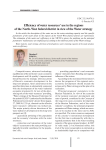Environmental economics. Рубрика в журнале - Economic and Social Changes: Facts, Trends, Forecast

Статья научная
One of the integral methods for assessing resource efficiency is the adjustment of net savings. It happens due to many indicators, including the assessment of specially protected natural territories. The author’s opinion is associated with the assessment of tourism activities at these sites and consideration of the value of regulating ecosystem territories’ services. The objectives of the study are the identification of approaches and assessment of protected areas; selection of “profitable” ecosystem services in regional protected areas; and submission of proposals for the effective usage of these territories. The calculation involves a combination of two methods: assessment of the gross value added of tourist destinations in protected areas and the value of regulatory ecosystem services. Tourism efficiency from the position of creating value chains destinations reflects the rate of gross value added, which is calculated as the difference between the proceeds from sales of tourist services entities and their material costs. To determine the economic value of regulatory services, the methods of market indirect assessment and compensation costs were used. During the calculation of ecosystem services, we selected those with beneficiaries located in the region. Increasing efficiency of facilities requires conditions for the development of recreation and new activities. These conditions are shown in the strengthening of interaction between administrations of protected areas with service companies that provide a quality factor of infrastructure, availability of facilities and food services. The economic contribution of specially protected natural areas from the usage of regulating ecosystem services and tourist and recreational activities amounted to 20.4 billion rubles, or 3.2% of gross regional product, in 2018. The proposed approach allows us to show the socio-economic and environmental contribution of specially protected natural areas to the economy of the Komi Republic.
Бесплатно
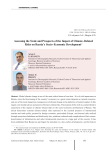
Статья научная
Global climate change is one of the most critical issues of our time. It is of vital importance to Russia, since the functioning of the country’s economy to a great extant depends on natural resources, and one of the most dangerous consequences of climate change is the depletion of natural capital. In this regard, one should take an assessment of climate-related risks. The purpose of the work is a comprehensive assessment of the impact of climate-related risks on the socio-economic development of Russia. The article determines external climate-related risks expressed in the external pressure of international treaties and trade policy, pursued by foreign countries, particularly Europe, and internal risks realized through ecosystem disbalance and biodiversity loss, epidemic outbreaks and complication of their course, deterioration of infrastructure and other fundamental structures in a large part of the country. It has been established that Russia has just begun the transition to a low-carbon development, and the feature of this process compared to other countries is a comprehensive approach that involves both greenhouse gas reduction and its absorption directly from the atmospheric air. Hydrogen economy plays a key-role in emission reduction; in order to absorb greenhouse gases from the atmosphere, it is planned to form industry for their utilization through building carbon polygons and farms. We have found that measures to reduce the country’s carbon footprint are now consistent and do not interfere with the interests of either business or government. However, the main issue, in our opinion, is the low rate of implementation of the measures taken relative to similar efforts of foreign countries, which to some extent gives foreign countries the opportunity, under the pretext of environmental policy, to influence the Russian economy and further hinder the Russian Federation in standing its ground in the international arena.
Бесплатно
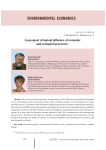
Assessment of mutual influence of economic and ecological processes
Статья научная
The article considers two issues: the assessment of the influence of economic development on the environment and the assessment of the impact of climate change on the development of certain economic sectors. The authors used methods of statistical analysis and economic-mathematical modeling. The article reveals differences in the dynamics and defines the nature of the relationship between GRP per capita and emissions of harmful substances into the atmosphere (including greenhouse gases) for Russia’s regions. It is shown that the dynamics in some regions in 2000-2011 corresponds to the environmental Kuznets curve. The factors that affect the reduction of anthropogenic impact were determined. Several models for estimating the impact of changes in climatic conditions on the productivity of various crops were designed and tested.
Бесплатно
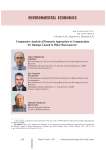
Comparative analysis of domestic approaches to compensation for damage caused to water bioresources
Статья научная
Issues related to renewable natural resources and compensation for damage to resources as a result of economic activities are in the focus of Russian and foreign scientists. The article presents domestic approaches to compensation for harm caused to water bioresources and their habitats. The purpose for the research is to conduct comparative analysis of two existing Russian approaches to compensation for harm caused to water bioresources: as a result of economic activities (construction of facilities, pipeline stringing., etc.) and illegal fishery of water biological resources (poaching). The authors conduct analysis of open data on water biological resources linkage, fishery yield and value characteristics of compensation through artificial reproduction of water bioresources as the main direction of natural resource recovery. The authors use data on the Arkhangelsk and Murmansk oblasts, Republic of Karelia, Komi Republic. They cover the issues of damage compensation from illegal extraction of water bioresources with use of the fixed charge approach...
Бесплатно
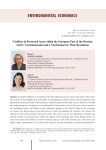
Статья научная
It would be difficult to overestimate the role of protected areas in the conservation of the Arctic nature. Due to their fragility and vulnerability to anthropogenic impacts, Arctic natural complexes need special and stricter protection. The importance of preserving the nature of the Arctic is also due to the fact that maintaining the environment in an undisturbed natural state is one of the main ways to preserve the traditional culture and lifestyle of the indigenous peoples of the North. However, the processes of creation and functioning of protected areas are often accompanied by conflicts; this reduces the efficiency of the entire network of protected areas. The article uses our own algorithm to identify and classify conflicts in protected areas within the regions of the European part of the Russian Arctic. In total, we revealed 138 conflicts in 21.6% of protected areas; 70.3% of the conflicts are in the most acute stage of open confrontation. As a result of the research, we have developed a universal mechanism for resolving conflict situations in protected areas. The mechanism is of a closed nature and includes the following implementation stages: setting a goal; analyzing conflicts that arise during the creation and functioning of protected areas; identifying stakeholders and their interests; identifying the subject and stage of the conflict; arranging the work of a platform for coordinating the interests of stakeholders; taking into account the priority of sustainable development in the territory; setting specific tasks and choosing conflict resolution tools; monitoring conflict situations in protected areas. We believe that the implementation of the proposed mechanism will ensure a balance of interests of the local population, economic entities, authorities and other interested parties, and will also contribute to sustainable socioi environmental and economic development in protected areas and in adjacent territories as well.
Бесплатно
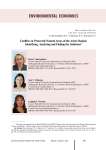
Статья научная
The increased attention paid by the state and the public to the Russian Arctic in recent years has led to a new round of its economic development. Nevertheless, major features of the Arctic nature are its vulnerability and the difficulty of recovery after anthropogenic impacts. This fact, as well as the exceptional climatic, ecological and cultural significance of the nature of the Russian Arctic, predetermines the need for its careful protection and for preservation of its fragile ecological balance. The defining role in these processes belongs to protected natural areas (PNS). Our paper emphasizes that one of the main barriers to the development of the network of protected natural areas both in Russia as a whole and in its Arctic territories consists in numerous conflict situations and disputes related to the organization and existence of protected areas. In the framework of the study, we develop a universal algorithm for analyzing the conflicts related to the establishment and functioning of protected areas. The proposed algorithm was tested on the example of the Arkhangelsk Oblast - the largest region in the European part of the Russian Arctic. Using content analysis, systematization, expert survey and general scientific research methods, we identify 58 conflict situations in 35 currently functioning protected areas and in two protected areas that are planned to be created in the region; we classify the situations according to the parties, subject and phase of the conflict. On the basis of this work, we formulate a set of specific recommendations to address, prevent and reduce the number of conflicts in the protected areas of the Arkhangelsk Oblast.
Бесплатно
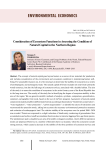
Статья научная
The concept of natural capital goes beyond nature as a source of raw materials for production and includes consideration of the environment and ecosystems condition in maintaining human wellbeing. For sustainable resource use, it is first necessary to determine the stability of ecosystems to a variety of anthropogenic and technogenic loads. The natural capital of forests includes not only forest (primarily wood) resources, but also the full range of ecosystem services, associated with a healthy habitat. The aim of the study is to assess the condition of ecosystems in the active forestry zone of the Komi Republic due to the long-term use. The novelty of the study lies in identifying the degree of ecosystem stability in this area of the region. We use general scientific methods of analysis, synthesis, comparison, generalization, computer-cartographic form tools, based on the use of ArcView program. Assessment of natural capital components made it possible to differentiate forestry according to the positions “biodiversity conservation”, “water regulation”, “water protection”, “carbon sequestration”; to identify the nature of restrictions and recommend the operation mode, taking into account the necessary environmental protection measures and reduction of anthropogenic load. The relative stability of the ecosystem over the period 2000-2020 was revealed. Threats are expressed in a slight reduction of biodiversity, weakening of groundwater flow accumulation and surface runoff accumulation functions due to intensive logging of low-age forest species. The predominant part is classified as an area of favorable ecological condition, where different operation modes are proposed. However, in a number of forestries there is a situation, when the ecosystem is under strong pressure, which caused a decrease in the stability of the three positions of ecosystem services and characterizes an unfavorable condition of the ecosystem. In this case, a particularly strict operation mode of forest ecosystems with maximum reduction of logging is recommended. Prospective studies are related to the cost estimation of ecosystem services to analyze the possibility of compensating funds for nature restoration in relation to large loggers in the region.
Бесплатно
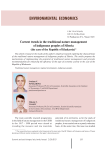
Статья научная
The article is based on the results of the author’s empirical research exploring the characteristics of the traditional nature management of indigenous peoples of Siberia. The article proposes the mechanisms of implementing the potential of traditional nature management and provides recommendations for enhancing the efficiency of this type of economic activity in the case of the Republic of Khakassia.
Бесплатно
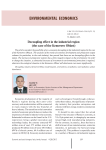
Decoupling effect in the industrial region (the case of the Kemerovo oblast)
Статья научная
The article considers the possibility of eco-economic decoupling in the industrial region (in the case of the Kemerovo Oblast). The analysis of the trends of economic development and production output volumes (in particular, in the coal industry) has proved that there are no decoupling effects in the region. The increase in production volumes has a direct negative impact on the environment. In order to change the situation, a substantial increase of investment in environmental protection is required, otherwise the ecological situation in the Kemerovo Oblast will deteriorate even more significantly.
Бесплатно
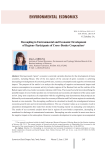
Статья научная
Moving towards “green” economy is currently a priority direction for the development of many countries, including Russia. One of the key aspects of the concept of green economy is achieving decoupling or misalignment of economic growth rates, resource consumption and negative environmental impact. The purpose of the article is to analyze the decoupling of negative environmental impact and resource consumption in economic activity in border regions of the Russian East and the entities of the Baikal region with cross-border economic relations with China. The research novelty lies in identifying the possible impact of cross-border position on environmental and economic development of the areas under review. Long-term experience of cooperation with the neighboring state demonstrates that prospects are followed by environmental problems since the economy of Siberian and Far Eastern regions is consistently focused on raw materials. The decoupling coefficient is calculated to identify the misalignment between economic growth rates and environmental pollution...
Бесплатно
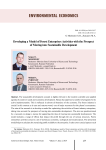
Статья научная
The sustainable development concept is highly relevant in the modern scientific and applied agenda of country’s social and economic development. Russia has approved a number of programs for its active implementation. This is reflected in almost all branches of the economy. The forest industry is crucial in this context as it uses and restores wood, one of major resources for the planet’s ecosystems. The aim of the research is to develop a model for optimizing the activities of forest industry enterprises, taking into account the prospects of moving into sustainable development. The aim was predetermined by a necessity to design a means for supporting the idea of moving into sustainable development. The model includes a range of effects that impact the profit through the use of various resources. Forest enterprises activities concern a set of technical, economic, ecological and social aspects. The presented model helps to calculate the remaining profit available to the enterprise. It also covers crucial aspects such as competitiveness and efficiency, which are determined by the effects of social, ecological and economic nature. An important finding is the demonstration ofthe need and interest of forest enterprises to fulfill the existing restrictions imposed by stakeholders. The presented results may be valuable for researchers of the forest sector economy and to the industry in general; for the federal authorities to implement sustainable development programs and create industrial policy; for the heads of forest businesses to develop relevant strategies and plans.
Бесплатно

Статья научная
In the Russian Non-Black Earth Region, an unacceptable contrast remains between the level of socio-economic development of cities and the presence of “desolation zones” in rural areas. In turn, rural areas of the regions are excessively differentiated and polarized. In some areas, innovative agricultural production is developing, and the number of rural residents is growing, in others, commodity production is declining, depopulation is increasing, and social desertification and space compression are taking place there. Socio-economic phenomena in rural areas depend on the directions and rates of dynamics of agricultural production. Hence, the main idea, presented in the article, is the consideration of differentiation process of agricultural production as the primary basis for the heterogeneity formation of rural areas. The purpose of the study is to identify the level and features of the formation of territorial differentiation of agricultural production in the Non-Black Earth Region during the planned (1974-1990) and market (1991-2019) economies, and to determine ways to reduce its excessive redundancy. At the same time, the authors analyze territorial differentiation from two sides: as a process and as a result of this process. Methodologically, the paper considers the development heterogeneity from the standpoint of the “center - periphery” concept and differential rent theory. The work uses the method of multicriteria stratification of the final rank scales. The ranking is carried out according to the Board rule, the countries are determined on ordinal scales using tertiles, quartiles, and quintiles. The article calculates the coefficients of Gini and funds. As a result, the authors have determined a sharp increase in interregional differentiation and polarization in the production of agricultural goods in 1991-2019. According to the dynamics of agricultural production in 1974-1990, there have been identified five types of regions, the rating positions of which have been transformed in six directions in the subsequent period. In conclusion, the authors have determined the aggregate level of interregional differentiation. The study identifies three groups and nine subgroups of regions, and defines the differences between them. The paper establishes current trends of the differentiation process in the production of agricultural goods, and proposes ways to reduce excessive differentiation and polarization of the regions.
Бесплатно
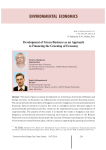
Development of green business as an approach to financing the greening of economy
Статья научная
The issues of green economy development are in the focus of attention of Russian and foreign scientists. Its formation was influenced by environmental activities financing sources. The article presents the description of budgetary and extra-budgetary environmental protection financing. Special attention is paid to the need to strengthen private financial support of environmentally determined activities, which can be implemented as part of development of ecopreneurship. The purpose of this article is to identify the trends in budgetary and extra-budgetary environmental protection financing and resource conservation in the Russian Federation and to rationalize theoretically the necessity of business participation in financing of environment-related business ideas, which is aimed at supporting the greening of economic activity at the regional level. The methods of empirical and statistical research, systematization and generalization of information have been used. SWOT analysis has identified the strengths and weaknesses of green business, as well as the opportunities for and threats to its development...
Бесплатно
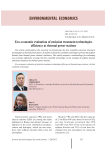
Eco-economic evaluation of emission treatment technologies efficiency at thermal power stations
Статья научная
The article substantiates the necessity of introducing the best available emission treatment technologies at thermal power plants. It studies in detail the available technologies of removing sulphur dioxide from thermal power stations’ emissions. The article proposes a methodology for evaluating eco-economic efficiency of using the best available technology on the example of sulphur dioxide emissions treatment by thermal power stations.
Бесплатно
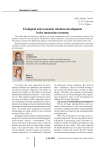
Ecological and economic relations development in the innovation economy
Статья научная
The article offers the analysis of efficiency of nature management tools in an innovation economy. The analysis is based on the innovations introduced by Mondi Syktyvkar in the field of environment protection. The authors stands for the differential approach with implementation of economic and administrative tools.
Бесплатно
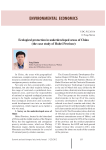
Ecological protection in underdeveloped areas of China (the case study of Hubei province)
Статья
Бесплатно
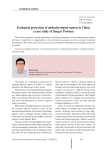
Ecological protection of underdeveloped regions in china: a case study of Jiangxi province
Статья научная
The article presented scientific approaches to ecological protection in the underdeveloped regions of China. It describes its organization in the periods of economic recovery and rapid economic development. The article also covers acute issues concerning the enhancement of ecological protection at present.
Бесплатно
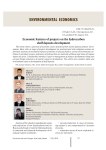
Economic features of projects on the hydrocarbon shelf deposits development
Статья научная
The article shows a spectrum of economic issues of hydrocarbon marine deposits projects' development. Basic risks at stages of projects development are analyzed and risks mitigation actions are provided. Analysis of investment expenses of marine oil and gas fields in various environmental conditions is provided; resource indicators of hydrocarbon raw materials of Russia and states of Caspian region are given. Considerable attention is paid to management of projects development taking into account foreign experience of natural resources development. The article also considers safety and environment issues at development of shelf deposits.
Бесплатно
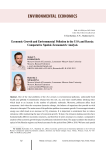
Статья научная
One of the vital problems of the 21st century is environmental pollution, unfavorable both locally and globally. Contaminants released into the soil, air, and water runoff pollute drinking water which leads to an increase in the number of epidemic outbreaks. Moreover, pollutants affect local ecosystems. And when the ecosystem dynamics change, the balance of organisms that provide us with clean air is disrupted. The main cause of the pollution problem is economic growth. It encourages intensive energy use which leads to an increase in СО2 emissions. It is important to understand how to reduce emissions while maintaining the pace of economic growth. To date, the emission-leading countries have fundamentally different economic structures, and therefore it seems necessary to conduct a comparative analysis of the economic growth impact on pollutant emissions for them. The paper considers the situation typical of the Russian regions and American states for the period from 2004 to 2018. We have used spatial econometric models to identify dependencies. The paper proves the existence of spatial correlation in the level of pollutant emissions in Russia’s regions and American states. We have confirmed the hypothesis that the dependence of emissions on economic growth in Russia’s regions has the form of an inverted U-shaped curve. The value of the GRP turning point, after reaching which the level of pollutant emissions will decrease, has shown that only in ten Russia’s regions, with GRP growth, emissions are reduced, and most regions are on the increasing part of the curve. For the United States, the estimates obtained are not significant, which proves the paramount importance of the structure of the country’s economy in the issue of the relationship between environmental pollution and economic growth.
Бесплатно

